I tried an intense cooking MasterClass—here's what I learned
Thomas Keller's course isn't just recipes.
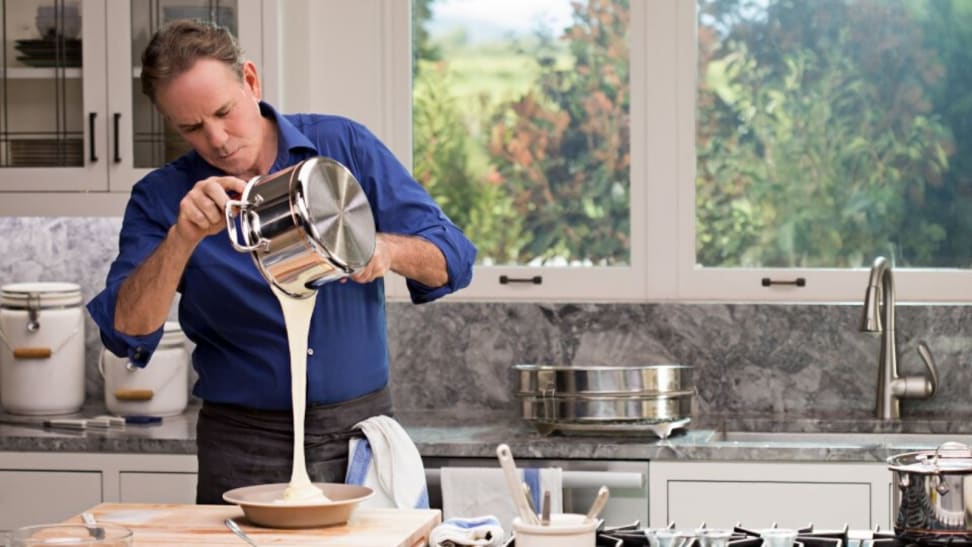 Credit:
MasterClass
Credit:
MasterClass
Products are chosen independently by our editors. Purchases made through our links may earn us a commission.
I’ve spent a lot more time in the kitchen since the pandemic started. Not only am I eating more meals at home, but I’ve found the rhythm of chopping vegetables soothing. However, after a few months of my same tried-and-true recipes, I’ve been craving more variety.
So I joined MasterClass, intent on learning a few dishes from Michelin-star chef and author of The French Laundry Cookbook, Thomas Keller.
The promotions for these inspirational courses are everywhere. Log into virtually any social media platform and you’ll see a celebrity’s face staring back, beckoning you to come see how they mastered their craft.
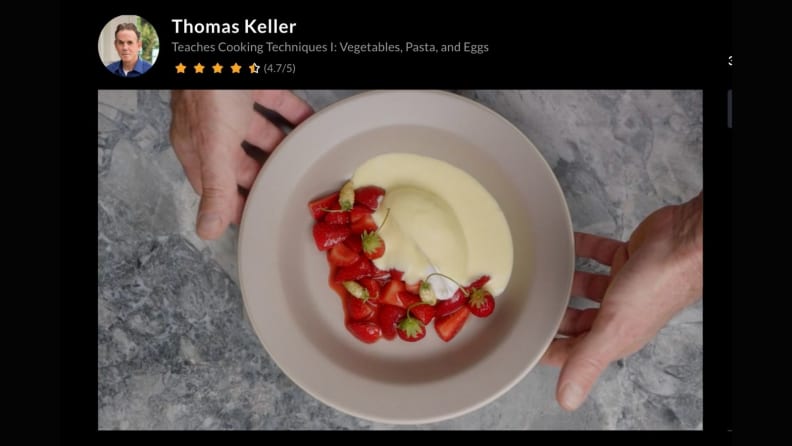
The Thomas Keller MasterClass offers 36 video lessons, each about 15 minutes long.
For those who somehow avoided their ads, MasterClass offers well-produced digital classes from a long list of celebrities on the methods behind their expertise. Each course is a series of short videos on a topic, depending on the teacher. For $180, you gain online access to their entire course catalogue for a year (and for half that, you can download a single class to keep forever).
As a self-taught home cook cooped up in my apartment, learning recipes, techniques, and a few basic skills from a professional chef online seemed like the way to go. While I expected to dive in and quickly learn a few new recipes, I was surprised to find that the recipes themselves were not the focus. Yes, I learned how to make some new dishes and a few new techniques—but I was mostly just inspired to experiment in the kitchen on my own.
How we tested
While the MasterClass trailers are beautiful, they don’t give a good sense of what a cooking class actually looks like—or where to start. And since grocery shopping isn’t as easy as it used to be, I decided to begin by watching the courses and then choosing which recipes to make. I figured I could go back and cook with Keller’s instruction on the second run.
The good and bad news is that Keller’s courses have a lot of content. His first course alone has 36 videos, many almost 15 minutes long, with a total time of 6 hours and 53 minutes. With the best of intentions, I watched the first 16—the introduction and kitchen essentials through the end of his section on vegetables—before starting to jump around.
Fortunately, each course also includes a recipe workbook. From this, I figured out what I wanted to make, hopped to the relevant videos, and listed out what I needed. Once I gathered my ingredients, I went back to the videos and rewatched with the recipe workbook open, pausing occasionally so I could follow along.
Ultimately, I was glad I started with the fundamentals and vegetables. Some later videos, including in different courses, touted full recipes that required techniques and side dishes Keller taught earlier. This doesn't make for the best experience if you’re trying to cook a single dish, but it forced me to think more broadly about how different pieces of a meal could be applied separately.
Recipes we tested
Before starting, I decided to test out four recipes—at least one from each course. What this ultimately meant, since I wanted to plate my meals just as Keller did, was actually making almost nine things. Together, they added up to one meat dish plated with a salad, one homemade pasta dish, a side of vegetables, and dessert. There are some of these that I’ve already made again, and some I don’t know if I will ever go back to.
Glazed Carrots
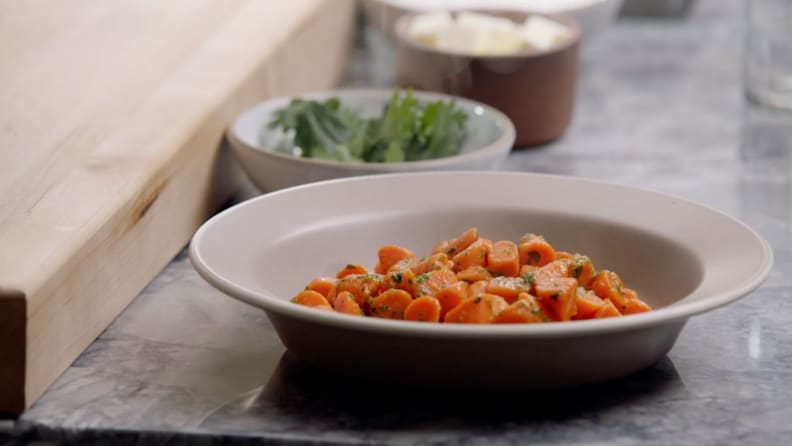
Glazed carrots are more challenging than you'd think.
This recipe was wonderfully straightforward, even if it took me twice as long to make as it did Keller. For this video, Keller teaches you how to add chopped carrots to a bit of sugar, butter, water, and vinegar to create a syrupy glazed carrot dish. The best part? You can do this with other vegetables, too.
While I already knew how to peel carrots, I did learn a new technique: how to cut them in an ‘oblique’ shape to add more texture to the dish by turning your carrot as you slice. I found this technique frustrating, as it was difficult to keep the pieces the same size. It got easier with practice, and I admit the result made me feel much fancier at the dinner table. The jury is still out on whether I’ll try this technique again.
My biggest problem with this dish, though, was that my carrots stayed firm for an unexpectedly long time. To glaze them, you put the sliced carrots in a pan, just barely cover them with water (adding butter and a bit of sugar and vinegar as well), and cook them over high heat until the water evaporates, leaving behind a glaze.
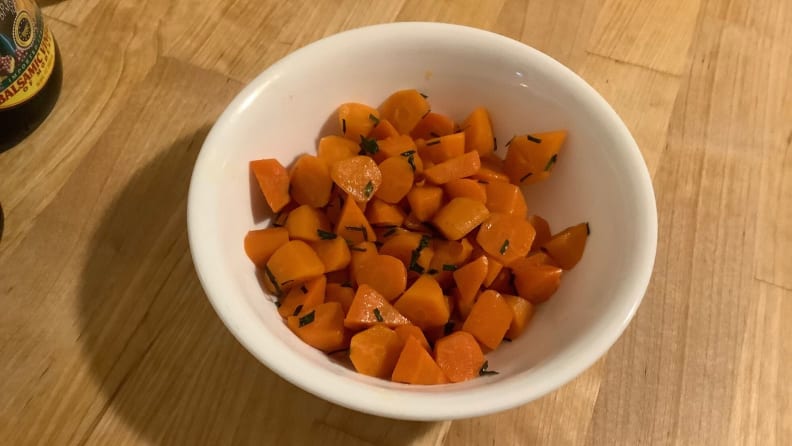
I was pleased with the result, although it took twice as long as expected.
But my water kept evaporating before the carrots were tender and glazed. Keller tells you how to handle this, but the video made the whole process seem much quicker than it ultimately was. It took Keller 10 or 15 minutes, while it took me closer to 40. Perhaps this will improve with practice.
But in the end, it tasted incredible. Being hungry after waiting for my carrots to soften probably didn’t hurt.
Pasta Agnolotti with Peas and Bacon
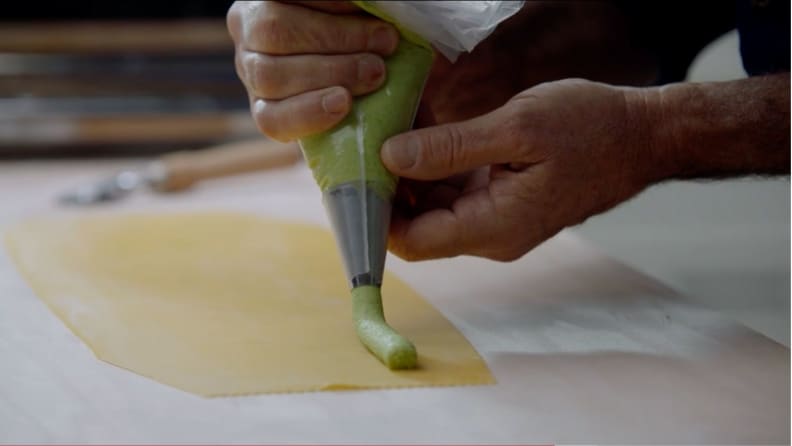
I knew that making pasta from scratch was going to be an adventure.
Making my own pasta seemed like a good challenge, and was something I’d always wanted to try. I picked this specific recipe because it not only required making my own pasta dough, but also a filling known as a "farce" to create what looked like a tiny, pretentious ravioli. The dish is also topped with a parmesan crisp, which just seemed like fun. The pasta for this dish was mostly eggs and flour, and the farce filling was made with peas and soft cheese. I don’t eat red meat, so I swapped out the bacon for red onions.
This recipe didn’t start off on the right foot. I felt like a bad student, unable to find the finely milled flour Keller suggested and unwilling to order it special online. I also drew the line at hunting for the jidori hens eggs he recommended. There was just no chance. Keller was a bit pretentious about it all, too.
As he talked about learning to make pasta in Italy, I marveled at how many eggs I needed. Fourteen yolks later, I finally followed his lead in making the pasta dough. It was a fun, messy process, but yielded an unexpectedly dry dough. I realized that not having feedback made learning difficult.
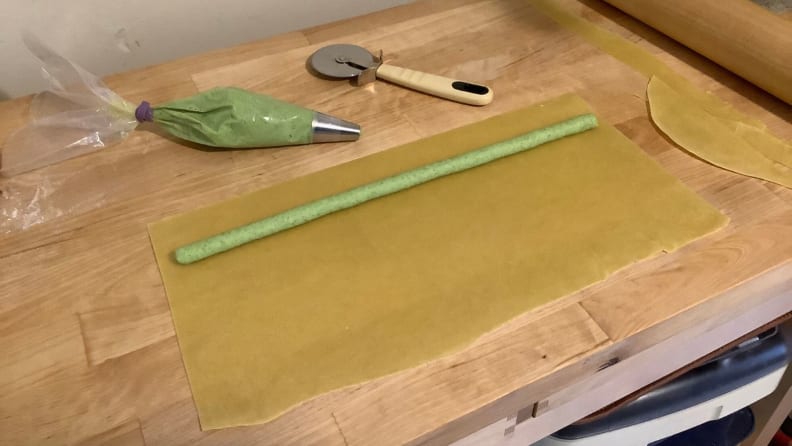
The dough was a bit dry and very hard to roll out by hand—do not recommend.
While the dough chilled, I made the farce. Once again, I declined to make or buy fancy bread just to make bread crumbs, so opted for a less wasteful alternative by using my already-open container from the store. I also realized I’d forgotten the mascarpone. (Lucky for me, cream cheese and heavy cream can be combined to form a close substitute.) Fortunately, even Keller recommends using frozen peas.
Mixing these ingredients together was easy, but straining them after blending was rough. Without the fancy drum sieve Keller recommends, I was stuck with my hand held sifter. It did the trick, but I was exhausted even before the pasta was ready.
The next task was rolling out the dough. I did this by hand, and I don’t recommend it. Once I was able to get it to the proper thinness, filling and shaping the pasta was more fun, but also had its share of pitfalls. I certainly appreciated having Keller to walk me through how to fold the pasta around the filling, but even with his instruction my filling burst through the dough in ways his did not.
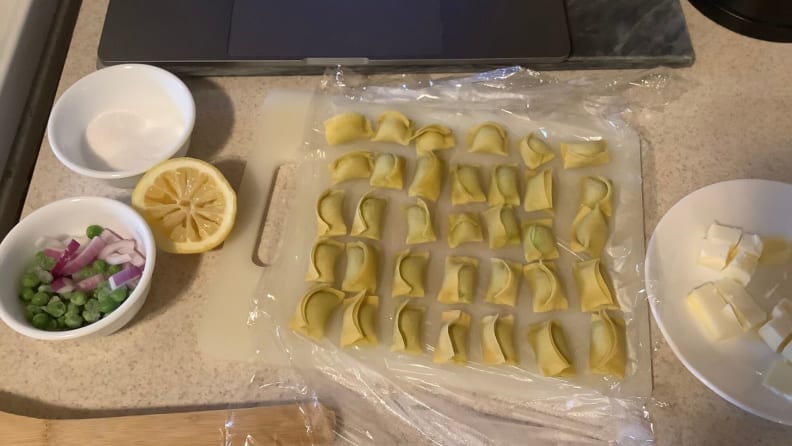
I closely followed Keller's instructions for filling and shaping the pasta.
Cooking the pasta, and making a sauce for it, was the easiest bit. But even then, if you leave it on even a few seconds too long your emulsification will split—and even the wisdom of Keller on your screen can’t help you repair it.
The best part of this recipe, which I will definitely make again, was the parmesan crisp. Gently cook some parmesan in a pan and mold it before it cools, and you’re left with a fancy bit of cheese to make any pasta dish look gourmet.
So while the results were incredible—I felt decadent eating this dish, even with the split sauce—the effort to get there wasn’t worth it. I might feel differently if I had a pasta maker, but for now my wrists and back need a break.
Chicken Paillard
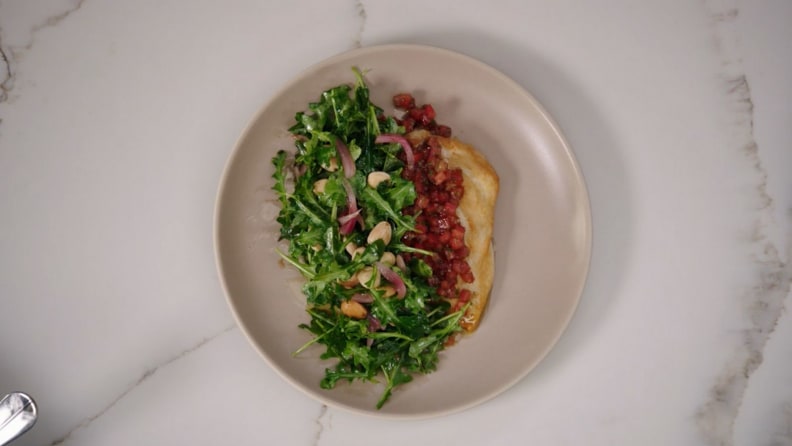
I was excited to try Thomas Keller's recipe for chicken paillard.
Although this dish was in the second Thomas Keller MasterClass course, it required techniques from the first course to complete. If you’re familiar with pickling onions and blanching tomatoes you could skip straight to it, but I was glad I had Keller to guide me on them as I hadn’t done either before. The recipe book included how to make each of these, but I found it valuable to flip back to the earlier video.
To get the complete plate, this recipe required a pounded and sautéed chicken breast, a sauce vierge, and an arugula salad garnished with pickled red onions. Pounding the chicken was a new thing for me, and a lot of fun.
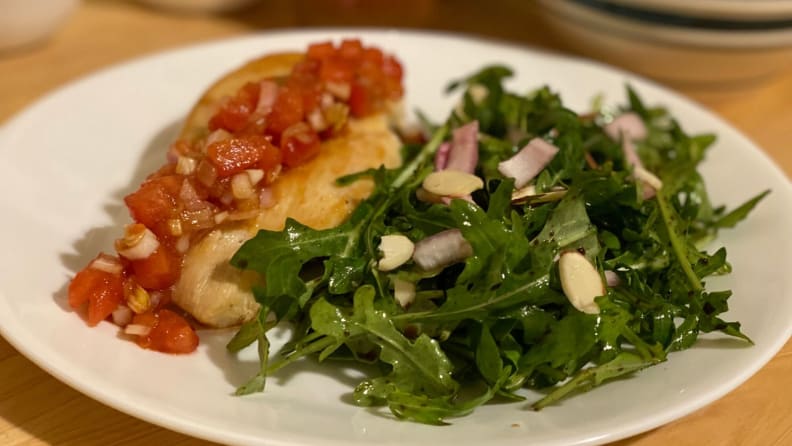
The dish was delicious, but I had trouble pounding the chicken to the right thickness.
However, I really wasn’t able to get it to an even thickness as Keller had instructed, making sautéing a different story. I almost never cook meat, and had to keep testing whether it was cooked through in the center. It was a frustrating experience, and I understood why Keller kept telling viewers to practice and be patient. I just wish he’d covered the question of “how do I tell if this is done in the middle?”
All told this meal was delicious. In the future though, I’m keeping a jar or three of pickled red onions in my fridge so I will have salad fixings already waiting. And the sauce vierge—really just chopped tomatoes with shallots, oil, vinegar, and salt—is better fresh, and I now know it can be made quickly if you know what you’re doing and makes a great addition to many different dishes.
Pots de Crème
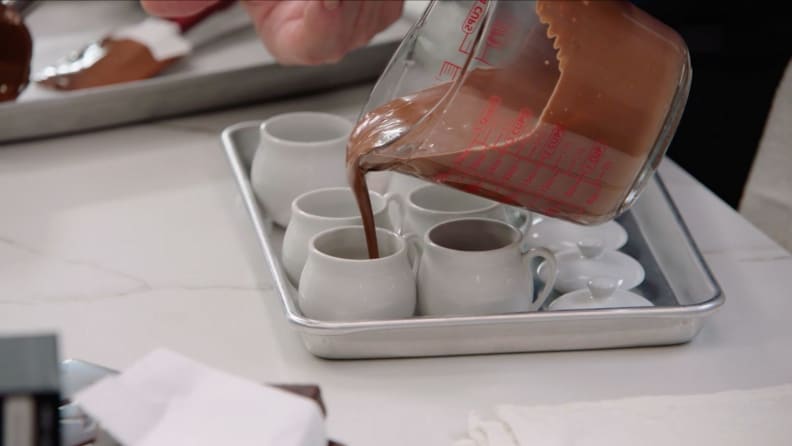
As a baker, I was less intimidated by his recipe for pots de crème.
Pots de crème is a rich chocolate custard topped with a sweetened whipped cream called crème Chantilly. The custard is similar to a silky smooth pastry cream or pudding, and made by heating milk, sugar, and egg yolks over the stove until thickened before adding chocolate and refrigerating.
I’m more of a baker than a chef, so I felt pretty comfortable tackling this recipe. That meant getting my milk to a simmer before adding the eggs was straightforward, even if it was hard to tell what it should look like on screen (personally, I always go by the smell). However, I was once again thrown off by the need to measure egg yolks by weight rather than number of eggs. Ultimately, I found the printed recipe more helpful than the video for this dish.
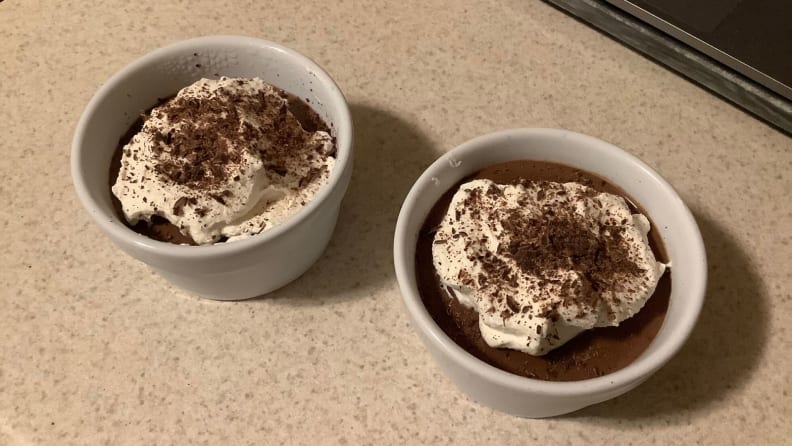
This dessert was absolutely delicious.
The end result: A lot of rich chocolate custard and crème, and two very happy people in my apartment.
Is Thomas Keller’s MasterClass worth it?
Whether this class is worth the price depends on what interests you about it. If you just want to learn to make a few of his recipes, I think you’re better off with his cookbook. But if you’re looking for new techniques, curious about the tools a professional chef recommends, or think you’d find value in exploring other classes as well, this could be a great subscription.
For $90, you can buy an individual course and have lifetime access to it on your computer. And for $180, you can get a year-long subscription to the entire course catalogue online. I don’t think an individual class would be worth it—particularly as Keller references techniques learned in earlier courses in his later videos. However, if you’re interested in more than just Keller’s courses and are motivated to watch them before the year is out, a full subscription has a lot to offer.
Personally, I enjoyed the first few videos on Keller’s cooking philosophy and kitchen tips, even if I rolled my eyes at his distaste for what he considers “gadgets” and how removed he feels from normal grocery stores. I also learned a lot from his different techniques, even if I will not be making many of the dishes he demos. It wasn’t the most practical cooking class, but it was a great quarantine activity—and I enjoyed the accomplishment of learning new meals.
If nothing else, watching these videos inspired me to try cooking new things in the kitchen. And reminded me that the best thing I can do to improve my skills is practice, practice, practice.
Sign up for Thomas Keller’s Cooking Techniques Course at MasterClass


